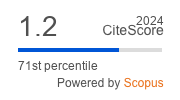Peculiarities of Modern English Multimodal Discourse
Keywords:
multimodality, multimodal discourse, verbal and non-verbal devices, visual literacy, systemic-functional approach.Abstract
This article deals with the investigation of English multimodal discourse. An outline is given of reasons for which it can be considered necessary to investigate verbal and non-verbal means used in written discourse for the implementation of communicative intentions. An analysis is made that focuses on multidimensional key theories, which make possible the study of the peculiarities of verbal and non-verbal means functioning in the English communicative space. Attention is also devoted to the interrelationship and the interdependence of several linguistic disciplines–graphic linguistics, social semiotics, visual linguistics, cognitive linguistics, visual communication, textual linguistics, communicative linguistics, multimodal theory and multimodal discourse–within which verbal and non-verbal devices are considered. The key concepts which are involved in considering multimodal discourse have also been described. Essential points and specifics relating to semiotic modes and resources have been explained, and distinctive features of multimodal discourse have been described. Some attention has been devoted to the systemic and functional approach to the investigation of multimodal discourse; it can also be applied to the problems related to literacy and to the writing skills which are necessary for all individuals in this digital age. Prospective approaches for further research have been pointed out, considering the latest communication trends which are inherent in the modern English-speaking world.
References
- Forceville, C. & Urios-Aparisi, E. (2009). Multimodal Metaphor. Berlin: Mouton de
Gruyter. - Forceville, C. (1994). Pictorial metaphor in advertisements. Metaphor and symbolic
activity, 9(1), 1–29. - Halliday, M. A. K. (2004). An Introduction to Functional Grammar. London: Arnold.
- Jewitt, C. (2009). The Routledge Handbook of Multimodal Analysis. London : Routledge.
- Kress, G. and Leeuwen, T. Van. (2001). Multimodal Discourse. Bloomsbury Academic.
- Kress, G. (2010). Multimodality: A Social Semiotic Approach to Contemporary
Communication. London: Routledge. - Kress, G. and Van Leeuwen, T. (2006). Reading Images: The Grammar of Visual Design.
London: Routledge. - Lakoff, G. and Johnson, M. (1980). Metaphors We Live by. Chicago: University of
Chicago Press. - Leeuwen, T. (2004). Introducing Social Semiotics: An Introductory Textbook. London :
Routledge. - Lester, P. (2006). Visual Communication: Images with Messages. Cаnada: Wadsowrth
Cengage Learning. - Makaruk, L. (2014). Poliphonichnist nominatsii semiotychno uskladnenykh tekstiv [The
variety of nomination of multimodal texts]. Nova Philologia, 59, 102 – 109. - Makaruk, L. (2014). Problemy doslidzhennya semiotychno uskladnenykh tekstiv [The
problems of the research of multimodal texts]. Naukovyi visnyk Chernivetskogo universytetu, 692-
693, 67–70.







 Creative Commons «Attribution» 4.0
Creative Commons «Attribution» 4.0